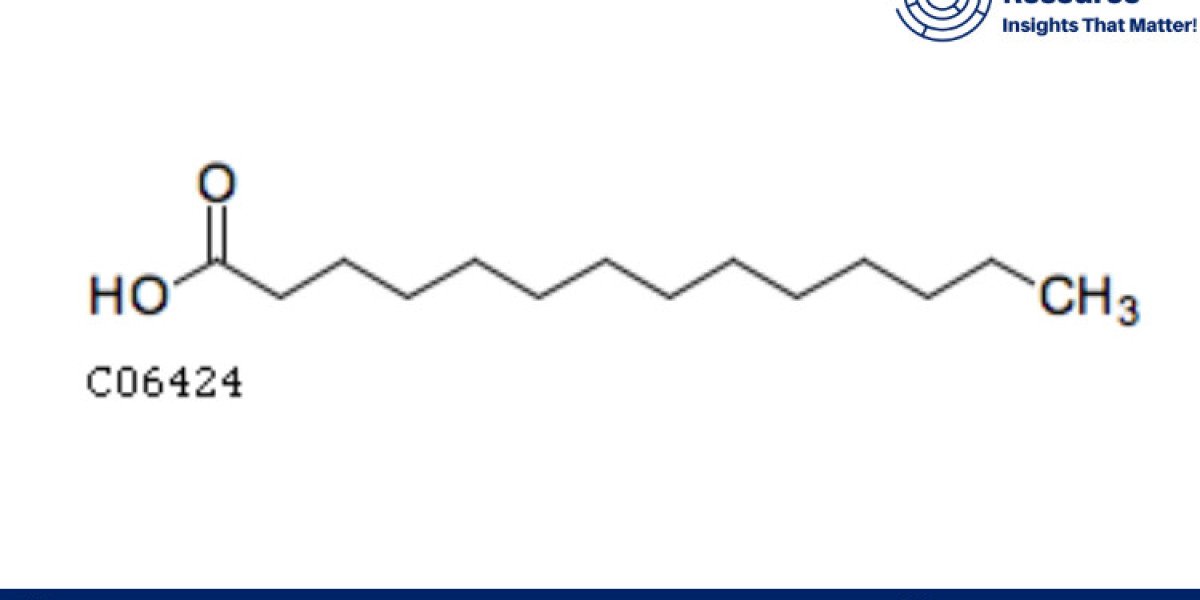Fatty acid C14, commonly known as myristic acid, is a saturated fatty acid widely used in cosmetics, personal care, food, and industrial applications. Its versatility and demand have made it an essential commodity in global markets, where tracking its price trends, fluctuations, and influencing factors is crucial for stakeholders. This report provides an in-depth analysis of the "Fatty Acid - C14 Price Trend," including price analysis, charts, news, indices, and graphical insights to offer a complete understanding of its market movement and projections.
Understanding the Fatty Acid - C14 Price Trend
The Fatty Acid - C14 Price Trend has been shaped by various factors, including supply chain dynamics, raw material availability, and demand across industries such as cosmetics, personal care, and pharmaceuticals. Myristic acid is often derived from plant and animal sources, primarily coconut and palm oils. As a result, global changes in the production and pricing of these raw materials have direct implications for fatty acid C14 prices.
Request a Free Sample – https://www.procurementresource.com/resource-center/fatty-acid-c14-price-trends/pricerequest
In recent years, the Fatty Acid - C14 market has seen noticeable price changes due to:
Raw Material Prices: The supply of coconut and palm oil, primary sources of myristic acid, affects fatty acid C14 pricing. Price fluctuations in these oils directly influence myristic acid costs, with coconut oil prices being particularly impactful due to its high C14 content.
Environmental Factors: Climate patterns impact the agricultural yield of coconut and palm oils, affecting the supply of myristic acid. Unfavorable weather conditions like droughts or floods can disrupt supply chains and cause price spikes.
Supply Chain Disruptions: Global shipping challenges, such as port congestions, increased fuel costs, and logistical delays, have contributed to cost increases in the transportation of myristic acid.
Regulatory Impacts: Growing demand for sustainable and eco-friendly practices in the production of fatty acids has led to stricter regulations, particularly in countries with substantial exports like Indonesia and Malaysia. Compliance costs related to sustainable practices can also impact prices.
Demand from Personal Care and Cosmetics: The cosmetics and personal care industry is a significant consumer of fatty acid C14, primarily for products that require smooth texture, emolliency, and skin conditioning properties. As demand in this sector grows, fatty acid C14 prices respond accordingly.
Fatty Acid - C14 Price Analysis
The Fatty Acid - C14 Price Analysis provides an in-depth view of how various factors influence pricing. It involves examining the cost structure, including raw materials, production processes, and distribution costs. Analyzing these components helps companies make informed decisions about purchasing, budgeting, and inventory management.
Raw Material Costs: The price of coconut and palm oils, as primary sources of myristic acid, is a core determinant of fatty acid C14 pricing. Market conditions for these oils are often influenced by geopolitical factors, agricultural output, and import-export regulations, impacting fatty acid C14 prices.
Production Costs: Manufacturing processes for fatty acid C14 require energy, water, and specialized equipment. Rising energy costs and resource scarcity have pushed up production costs, directly influencing fatty acid C14 prices.
Logistics and Distribution: The global distribution of fatty acid C14 is influenced by international shipping rates and logistics availability. Price surges in transportation can significantly increase the overall cost of fatty acid C14, especially when shipping from major production hubs in Southeast Asia.
Currency Exchange Rates: Since fatty acid C14 is globally traded, currency exchange rates play a role in pricing. Fluctuations in the value of currencies in major exporting countries like Malaysia or the Philippines affect the costs for importers and, ultimately, the global market price.
Fatty Acid - C14 Price Chart
A Fatty Acid - C14 Price Chart is an essential tool for visualizing price trends over specific periods. The chart typically displays historical prices, showcasing short-term and long-term trends. For businesses and investors, a price chart offers a quick, clear perspective on how myristic acid prices have shifted, allowing for comparison with other commodities and potential market influencers.
In recent years, price charts for fatty acid C14 have shown:
Seasonal Variations: Price charts often reveal seasonal trends that correspond with the harvest periods for coconut and palm oils. Prices tend to be lower during peak harvest times and higher when supply is constrained.
Market Peaks and Troughs: Sudden price increases or declines can often be traced back to environmental impacts, supply chain disruptions, or regulatory changes. For instance, a spike in fatty acid C14 prices in early 2021 was partly due to supply disruptions caused by the pandemic.
Comparative Analysis: By comparing fatty acid C14 prices with those of similar fatty acids (like lauric acid or stearic acid), businesses can assess relative market stability or volatility in the fatty acid sector.
Fatty Acid - C14 Price News
Keeping track of Fatty Acid - C14 Price News helps businesses stay updated on the latest factors affecting myristic acid pricing. Market news can offer insights into trends, regulatory changes, environmental factors, and other critical updates that influence fatty acid C14 prices.
Key sources of fatty acid C14 price news include:
Global Trade Reports: Export and import statistics from major producing countries like Indonesia, Malaysia, and the Philippines provide insight into market availability and pricing. Trade restrictions or tariff changes, for instance, can lead to immediate price changes.
Environmental Updates: Since myristic acid is derived from plant-based oils, any environmental impact that affects the yield of coconut and palm oils can influence fatty acid C14 pricing. Droughts, floods, and other climate events impacting oil production are frequently reported in agricultural and environmental news.
Policy Announcements: Regulatory bodies and government agencies periodically release updates on policies affecting the production of raw materials for fatty acid C14. For instance, new sustainability guidelines for palm oil production could affect myristic acid pricing by increasing compliance costs.
Industry Reports: Reports from the cosmetics, food, and industrial sectors provide an outlook on fatty acid demand trends, impacting fatty acid C14 prices. As demand fluctuates in these key sectors, pricing often responds accordingly.
Fatty Acid - C14 Price Index
The Fatty Acid - C14 Price Index serves as an aggregate measure of pricing changes over time, offering a comprehensive perspective on market stability or volatility. The index helps businesses track overall price trends rather than focusing on isolated events, allowing them to make informed long-term decisions.
The fatty acid C14 price index has shown:
Volatility Indicators: The index captures price volatility, indicating periods when the market is particularly unstable. High volatility often correlates with supply chain disruptions, such as the effects seen during the COVID-19 pandemic.
Trend Tracking: Price indices reveal if the market is experiencing an upward or downward trend, helping stakeholders understand whether prices are on a long-term rise or decline. For instance, a steady rise in the index over several months could indicate sustained demand outpacing supply.
Economic Insights: By comparing the fatty acid C14 price index with other commodities, businesses can gauge how broader economic conditions impact myristic acid pricing. If the index shows rapid shifts compared to other commodities, it may reflect unique supply constraints or demand surges specific to the fatty acid market.
Fatty Acid - C14 Price Graph
A Fatty Acid - C14 Price Graph is a detailed graphical representation of price movements, displaying data points over time to highlight trends and fluctuations. Unlike a simple chart, a price graph can incorporate various metrics and comparisons, offering a more nuanced view of pricing patterns.
In a typical fatty acid C14 price graph, you’ll find:
Historical Price Trends: A price graph often includes several years of data, showing long-term trends and cyclical patterns. This is particularly useful for identifying any regular fluctuations in fatty acid C14 prices due to seasonal demand or supply factors.
Comparison with Related Markets: Price graphs sometimes include data for related commodities, such as other fatty acids or oils, allowing stakeholders to see correlations between the prices of myristic acid and other products. For instance, a parallel increase in coconut oil and fatty acid C14 prices may signal raw material-driven cost changes.
Impact Analysis: A graph can highlight the impact of specific events, such as regulatory changes, natural disasters, or shifts in demand, making it easier to connect market changes with price movements.
Contact Us
Company Name: Procurement Resource
Contact Person: Amanda Williams
Email: sales@procurementresource.com
Toll-Free Numbers:
USA copyright: 1 307 363 1045
UK: 44 7537171117
Asia-Pacific (APAC): 91 1203185500
Address: 30 North Gould Street, Sheridan, WY 82801, USA








